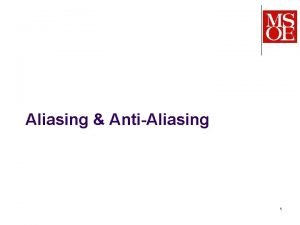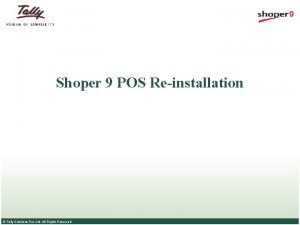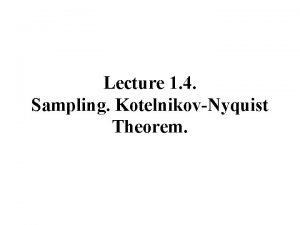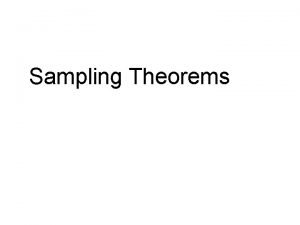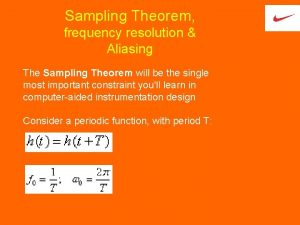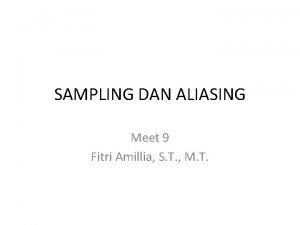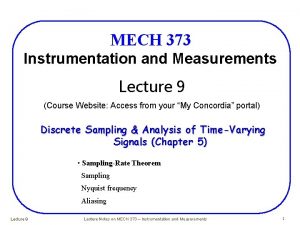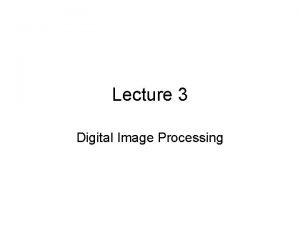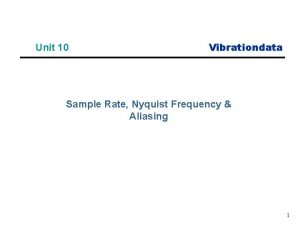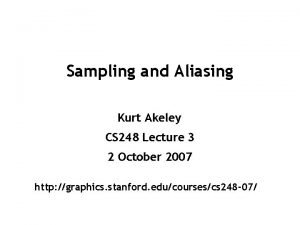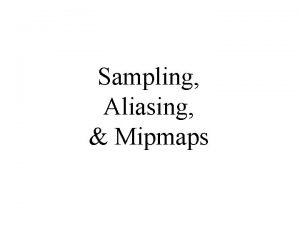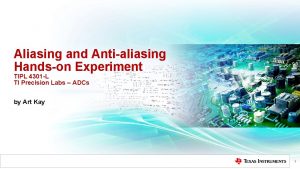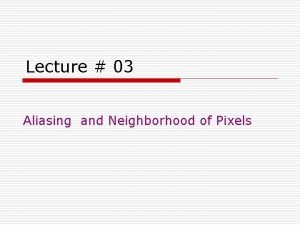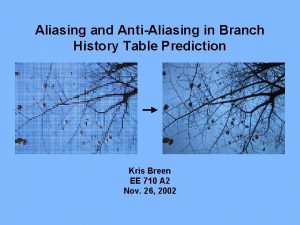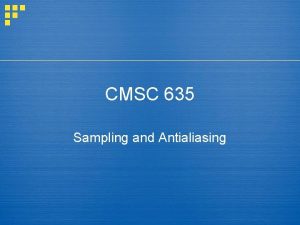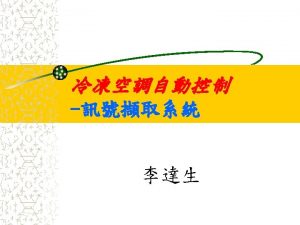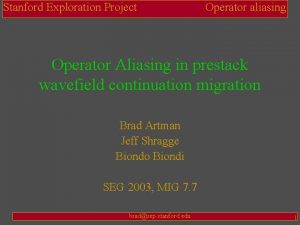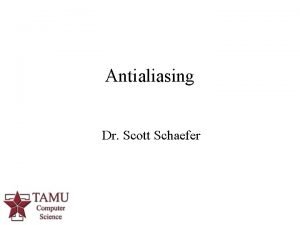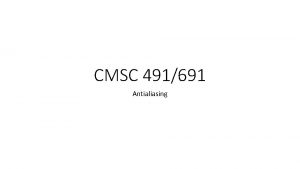Quiz Aliasing and Antialiasing Filters TIPL 4304 TI












- Slides: 12

Quiz: Aliasing and Anti-aliasing Filters TIPL 4304 TI Precision Labs – ADCs Created by Art Kay 1

Quiz: Aliasing and Anti-aliasing Filters 1. How do you determine Nyquist frequency? a) It is equal to the sampling rate of the data converter. b) It is equal to twice the sampling rate of the converter. c) It is equal to half the sampling rate of the converter. d) It depends on the anti-aliasing filter. 2. Applying an input signal that exceeds the Nyquist frequency will ____. a) Cause an erroneous “alias” signal to be measured by the ADC. b) Cause damage to the ADC. c) Introduce significant distortion in the signal. d) Cause a dramatic reduction in SNR. 2

Quiz: Aliasing and Anti-aliasing Filters 3. A data converter has a sampling rate of 1 MHz. The input amplifier has a second order low pass filter with a cutoff frequency of 1 MHz. What is a potential issue? a) No problem, this configuration will work well for antialiasing. b) Any input form 500 k. Hz to 1 MHz will not be attenuated at all and will produce aliases. c) A second order filter will not work for antialiasing. d) A band pass filter is required for antialiasing. 4. A data converter has a sampling rate of 1 MHz. A 900 k. Hz input signal is applied. What frequency will show up in the FFT? a) 100 k. Hz. b) 400 k. Hz. c) 500 k. Hz d) No result will be displayed as this exceeds the Nyquist frequency. 3

Quiz: Aliasing and Anti-aliasing Filters 4. Design an anti aliasing filter for a data converter with a 1 Msps sampling rate. The desired input signal range is 0 to 100 k. Hz. The filter must attenuate all alias input signals by at least 40 d. B. Use Filter. Pro or Filter Designer to design the circuit. Below is a link to Filter. Pro. This is a downloadable active filter design tool that helps design op amp active filters. https: //e 2 e. ti. com/support/amplifiers/precision_amplifiers/w/design_notes/3076. filterpro-v 3 -1 Below is a link to Filter Designer. This is an on-line active filter design tool that helps design op amp active filters http: //www. ti. com/design-tools/signal-chain-design/webenchfilters. html? key. Match=filter%2520 designer&tisearch=Search-EN-Everything 4

Solutions 5

Quiz: Aliasing and Anti-aliasing Filters 1. How do you determine Nyquist frequency? a) It is equal to the sampling rate of the data converter. b) It is equal to twice the sampling rate of the converter. c) It is equal to half the sampling rate of the converter. d) It depends on the anti-aliasing filter. 2. Applying an input signal that exceeds the Nyquist frequency will ____. a) Cause an erroneous “alias” signal to be measured by the ADC. b) Cause damage to the ADC. c) Introduce significant distortion in the signal. d) Cause a dramatic reduction in SNR. 6

Quiz: Aliasing and Anti-aliasing Filters 3. A data converter has a sampling rate of 1 MHz. The input amplifier has a second order low pass filter with a cutoff frequency of 1 MHz. What is a potential issue? a) No problem, this configuration will work well for antialiasing. b) Any input form 500 k. Hz to 1 MHz will not be attenuated at all and will produce aliases. c) A second order filter will not work for antialiasing. d) A band pass filter is required for antialiasing. 4. A data converter has a sampling rate of 1 MHz. A 900 k. Hz input signal is applied. What frequency will show up in the FFT? a) 100 k. Hz. b) 400 k. Hz. c) 500 k. Hz d) No result will be displayed as this exceeds the Nyquist frequency. 7

Quiz: Aliasing and Anti-aliasing Filters 4. Design an anti aliasing filter for a data converter with a 1 Msps sampling rate. The desired input signal range is 0 to 100 k. Hz. The filter must attenuate all alias input signals by at least 40 d. B. Use Filter. Pro or Filter Designer to design the circuit. A simple graphical method can be used to estimate the filter order if you don’t use a filter design package. You will see in the next few slides that Filter. Pro will give more accurate and detailed results. 8

Quiz: Aliasing and Anti-aliasing Filters 4. Design an anti aliasing filter for a data converter with a 1 Msps sampling rate. The desired input signal range is 0 to 100 k. Hz. The filter must attenuate all alias input signals by at least 40 d. B. Use Filter. Pro or Filter Designer to design the circuit. 1. Using Filter. Pro we can select low pass filter. 2. Using Filter. Pro we can enter the passband frequency, stopband frequency and stopband attenuation. 9

Quiz: Aliasing and Anti-aliasing Filters 4 (continued) Using filter Pro. 3. Next, using Filter. Pro we can select the filter type. Bessel is a very common filter type used for antialiasing 4. Next, using Filter. Pro we can select the topology. Sallen-Key works for non-inverting topology. 10

Quiz: Aliasing and Anti-aliasing Filters 4. Finally, Filter. Pro provides the active filter component selection that will meet your requirements. 11

Quiz: Aliasing and Anti-aliasing Filters The final filter can be verified using simulation in TINA. 12
